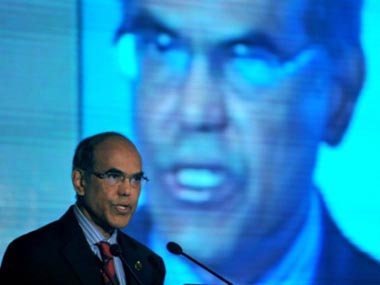The Reserve Bank of India on Friday disclosed what happened at the last technical advisory committee (TAC) meeting on 18 January: Governor Duvvuri Subbarao had to plough a lone furrow on holding interest rates.
In the policy announced on 24 January, Subbarao reduced the cash reserve ratio (CRR) by 50 basis points (100 basis points make 1 percent) due to liquidity concerns, but he held the line on rate cuts since there was no sign of any roadmap for fiscal consolidation.
According to the minutes of TAC - an advisory body comprising internal and external members rendering non-binding advice to the governor on monetary policy - a majority of the external advisors called for an easing of interest rates. Some clearly said the RBI must now target slowing growth instead of inflation.
This is how the advice went: Three external members called for a repo rate cut by 25 basis points. A fourth wanted it cut by 50 basis points. Of these four, two wanted to top up the repo cut with a CRR cut (25-50 basis points). Two other members did not suggest any CRR change, and three others did not call for a repo cut. Among those who didn’t want a repo cut, one called for a 25 basis points CRR reduction to ease liquidity. Two others said CRR should not be cut with the monetary policy - but at a different time.
[caption id=“attachment_217648” align=“alignleft” width=“380” caption=“The governor’s unstated job is to serve as a the economy’s risk-manager. He has to weigh several risks before taking his call. AFP”]  [/caption]
Impact Shorts
More ShortsThe minutes show TAC members affirming the economic (and investment) slowdown, but they were divided on what would really happen. Some agreed that “high interest rates had impacted investment”, but then, “the overall investment sentiment was also subdued because of the structural and confidence issues that had not been addressed.”
The committee also had differing views on the prognosis for next year. “Some members feltthat the slowdown in investment would affect next year’s growth as well. Besides, it would also have implications for inflation, going forward.Some members, therefore, suggested that the policy focus should change from managing inflation to managing slowdown in investment.”
Taking all the views together, it seemed like the weight of opinion was tilting towards a repo cut - with or without an accompanying CRR cut.
The monetary policy announced on 24 January, however, has all the hallmarks of Subbarao taking his own final call. He announced a 50 basis points CRR cut, but preferred to link it to liquidity conditions. It was not a signal that rates were all set to tumble.
He said: “In reducing the CRR, the Reserve Bank has attempted to address the structural pressures on liquidity in a way that is not inconsistent with the prevailing monetary stance.” (Read his key statements here ).
He also said: “In the two previous guidances, it was indicated that the cycle of rate increases had peaked and further actions were likely to reverse the cycle. Based on the current inflation trajectory, including consideration of suppressed inflation, it is premature to begin reducing the policy rate. The reduction in the policy rate will be conditioned by signs of sustainable moderation in inflation.”
From all this, it is clear that Subbarao remains unconvinced about the future direction of inflation, and remains a rate hawk.
Is the governor right to remain a hawk in the face of clear signs of an economic slowdown, where the GDP estimates now point to 6.9 percent growth in 2011-12?
The answer is yes.
Reason: the governor’s role is not to merely look at the numbers and come to quick conclusions about where rates should head. His unstated job is to serve as a the economy’s risk-manager. He has to weigh several risks before taking his call. Among them:
• Will the finance minister really announce clear steps towards fiscal consolidation and get a grip on runaway subsidies?
• What are the chances of food inflation re-surfacing if supply side measures to improve measures don’t happen or don’t work?
• Will the external environment - currently looking bullish due to the liquidity unleashed by the European Central Bank - hold its optimism?
• What if foreign inflows suddenly stop due to a euro event risk, or sudden fears of a fiscal mess-up in India due to a loss of nerve at the finance ministry before the budget?
• Then there is the political risk on what will happen after the UP elections. The Congress loss in Mumbai is a wake up call that the urban vote cannot be taken for granted.
If we take the RBI’s main role as an apolitical risk manager, Subbarao is clearly right to take a more cautious view compared to his political bosses. He has to keep the powder dry against future fiscal relapses.
Subbarao did the right thing by holding off on a more chirpy policy statement. As the Kotak Mahindra ad goes: “Subbu sab jaanta hai…”
Watch video:


)

)
)
)
)
)
)
)
)



